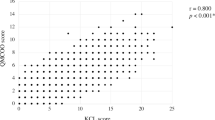Abstract
Background
Although frailty status greatly impacts health care in countries with rapidly aging populations, little is known about the frailty status in Chinese older adults.
Objectives
Given the increased health care needs associated with frailty, we sought to develop an easily applied self-report screening tool based on four of the syndromic frailty components and sought to validate it in a population of older adults in China.
Design
Prospective epidemiological cohort study.
Setting
Community-dwelling residents living in Beijing, China.
Participants
1724 community-dwelling adults aged ≥60 years in 2004 with an 8-year follow up.
Measurements
We developed a simple self-report frailty screening tool—the Frailty Screening Questionnaire (FSQ)—based on the modified Fried frailty components. The predictive ability for outcome was assessed by age and sex adjusted Cox proportional hazards model.
Results
According to FSQ criteria, 7.1% of the participants were frail. Frailty was associated with poor physical function, fractures, falls, and mortality. Both frailty and pre-frailty were associated with a higher mortality rate: frailty—hazards ratio (HR), 3.94, 95% confidence interval (CI), 3.16–4.92, P<0.001; pre-frailty—HR, 1.89; 95% CI, 1.57–2.27, P <0.001; adjusted models for this variable did not affect the estimates of the association. Among the four frailty components, slowness was the strongest predictor of mortality. The combination of the four components provided the best risk prediction.
Conclusions
FSQ is a self-report frailty measurement tool that can be rapidly performed to identify older adults with higher risk of adverse health outcomes.
Similar content being viewed by others
References
Dent E, Kowal P, Hoogendijk EEO. Frailty measurement in research and clinical practice: A review. Eur J Intern Med 2016;31:3–10.
Morley JE, Vellas B, Abellan van Kan G, et al. Frailty consensus: A call to action. J Am Med Dir Assoc 2013;14:392–7.
Fried LP, Tangen CM, Walston J, et al. Frailty in Older Adults: Evidence for a Phenotype. Journals Gerontol Ser A Biol Sci Med Sci 2001;56:M146–57.
Rockwood K, Mitnitski A. Frailty in relation to the accumulation of deficits. J Gerontol A Biol Sci Med Sci 2007;62:722–7.
Zaslavsky O, Zelber-Sagi S, Gray SL, et al. Comparison of Frailty Phenotypes for Prediction of Mortality, Incident Falls, and Hip Fracture in Older Women. J Am Geriatr Soc 2016;64:1858–62.
Paulson D, Lichtenberg PA. The Paulson–Lichtenberg Frailty Index: evidence for a self-report measure of frailty. Aging Ment Health 2017;19:892–901.
Buta BJ, Walston JD, Godino JG, et al. Frailty assessment instruments: Systematic characterization of the uses and contexts of highly-cited instruments. Ageing Res Rev 2016;26:53–61.
Zimmer Z, Kaneda T, Tang Z, Fang X. Explaining Late Life Urban vs. Rural Health Discrepancies in Beijing. Soc Forces 2010;88:1885–908.
Ma L, Zhang L, Tang Z, et al. Use of the frailty index in evaluating the prognosis of older people in Beijing: A cohort study with an 8-year follow-up. Arch Gerontol Geriatr 2016;64:172–7.
Ma L, Zhao X, Tang Z, et al. Epidemiological characteristics of hypertension in the elderly in Beijing, China. PLoS One 2015;10:1–8.
Ma L, Tang Z, Sun F, et al. Risk factors for depression among elderly subjects with hypertension living at home in China. Int J Clin Exp Med 2015;8:2923–8.
Wu C, Smit E, Xue Q-L, Odden MC. Prevalence and Correlates of Frailty among Community-Dwelling Chinese Older Adults: The China Health and Retirement Longitudinal Study. J Gerontol A Biol Sci Med Sci 2017;73:102–108.
Ma L, Tang Z, Zhang L, Sun F, Chan P. Prevalence of frailty and associated factors in the community-dwelling population of China. J Am Geriatr Soc 2018;66:559–564.
Zheng Z, Guan S, Ding H, et al. Prevalence and Incidence of Frailty in Community-Dwelling Older People: Beijing Longitudinal Study of Aging II. J Am Geriatr Soc 2016;64:1281–6. doi:10.1111/jgs.14135.
Shi J, Yang Z, Song X, et al. Sex differences in the limit to deficit accumulation in late middle-aged and older Chinese People: Results from the Beijing longitudinal study of aging. J Gerontol A Biol Sci Med Sci 2014;69:702–9. doi:10.1093/gerona/glt143.
Rockwood K, Howlett SE, MacKnight C, et al. Prevalence, attributes, and outcomes of fitness and frailty in community-dwelling older adults: report from the Canadian study of health and aging. J Gerontol A Biol Sci Med Sci 2004;59:1310–7. doi:10.1093/gerona/59.12.1310.
Bandeen-Roche K, Seplaki CL, Huang J, et al. Frailty in Older Adults: A Nationally Representative Profile in the United States. Journals Gerontol Ser A Biol Sci Med Sci 2015;70:1427–34.
Gordon EH, Peel NM, Samanta M, Theou O, Howlett SE, Hubbard RE. Sex differences in frailty: A systematic review and meta-analysis. Exp Gerontol 2017;89:30–40.
Hoogendijk EO, Abellan van Kan G, Guyonnet S, Vellas B, Cesari M. Components of the Frailty Phenotype in Relation to the Frailty Index: Results From the Toulouse Frailty Platform. J Am Med Dir Assoc 2015;16:855–9.
Woo J. Walking Speed: A Summary Indicator of Frailty? J Am Med Dir Assoc 2015;16:635–7.
Studenski S, Perera S, Patel K. Gait speed and survival in older adults. JAMA 2011;305:50–8.
Woo J, Leung J, Zhang T. Successful Aging and Frailty: Opposite Sides of the Same Coin? J Am Med Dir Assoc 2016;17:797–801.
Mitnitski AB, Mogilner AJ, Rockwood K. Accumulation of Deficits as a Proxy Measure of Aging. Sci World J 2001;1:323–36.
Turner G, Clegg A. Best practice guidelines for the management of frailty: a British Geriatrics Society, Age UK and Royal College of General Practitioners report. Age Ageing 2014;43:744–7.
Author information
Authors and Affiliations
Corresponding authors
Electronic supplementary material
Rights and permissions
About this article
Cite this article
Ma, L., Tang, Z., Chan, P. et al. Novel Frailty Screening Questionnaire (FSQ) Predicts 8-Year Mortality in Older Adults in China. J Frailty Aging 8, 33–38 (2019). https://doi.org/10.14283/jfa.2018.38
Received:
Accepted:
Published:
Issue Date:
DOI: https://doi.org/10.14283/jfa.2018.38




